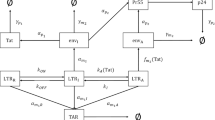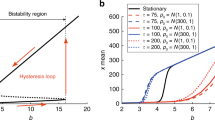Abstract
Steady-state behavior and bistability have been proposed as mechanisms for decision making in gene circuits1,2,3. However, transient gene expression has also been proposed to control cell fate4,5, with the decision arbitrated by the duration of a transient gene expression pulse. Here, using an HIV-1 model system, we directly quantify transcriptional feedback strength and its effects on both the duration of HIV-1 Tat transcriptional pulses and the fate of HIV-infected cells. By measuring shifts in the autocorrelation of noise inherent to gene expression, we found that transcriptional positive feedback extends the single-cell Tat expression lifetime two- to sixfold for both minimal Tat circuits and full length, actively replicating HIV-1. Notably, artificial weakening of Tat positive feedback shortened the duration of Tat expression transients and biased the probability in favor of latency. Thus, transcriptional positive feedback can modulate transient expression lifetime to a greater extent than protein half-life modulation, and it has a critical role in the cell-fate decision in HIV.
This is a preview of subscription content, access via your institution
Access options
Subscribe to this journal
Receive 12 print issues and online access
$209.00 per year
only $17.42 per issue
Buy this article
- Purchase on Springer Link
- Instant access to full article PDF
Prices may be subject to local taxes which are calculated during checkout




Similar content being viewed by others
References
Ozbudak, E.M., Thattai, M., Lim, H.N., Shraiman, B.I. & Van Oudenaarden, A. Multistability in the lactose utilization network of Escherichia coli. Nature 427, 737–740 (2004).
Arkin, A., Ross, J. & McAdams, H.H. Stochastic kinetic analysis of developmental pathway bifurcation in phage lambda-infected Escherichia coli cells. Genetics 149, 1633–1648 (1998).
Bagowski, C.P. & Ferrell, J.E. Jr. Bistability in the JNK cascade. Curr. Biol. 11, 1176–1182 (2001).
Suel, G.M., Garcia-Ojalvo, J., Liberman, L.M. & Elowitz, M.B. An excitable gene regulatory circuit induces transient cellular differentiation. Nature 440, 545–550 (2006).
Maamar, H., Raj, A. & Dubnau, D. Noise in gene expression determines cell fate in Bacillus subtilis. Science 317, 526–529 (2007).
Seth, N., Kaufmann, D., Lahey, T., Rosenberg, E.S. & Wucherpfennig, K.W. Expansion and contraction of HIV-specific CD4 T cells with short bursts of viremia, but physical loss of the majority of these cells with sustained viral replication. J. Immunol. 175, 6948–6958 (2005).
Perelson, A.S., Neumann, A.U., Markowitz, M., Leonard, J.M. & Ho, D.D. HIV-1 dynamics in vivo: virion clearance rate, infected cell life-span, and viral generation time. Science 271, 1582–1586 (1996).
Finzi, D. et al. Identification of a reservoir for HIV-1 in patients on highly active antiretroviral therapy. Science 278, 1295–1300 (1997).
Chun, T.W. et al. Presence of an inducible HIV-1 latent reservoir during highly active antiretroviral therapy. Proc. Natl. Acad. Sci. USA 94, 13193–13197 (1997).
Pierson, T., McArthur, J. & Siliciano, R.F. Reservoirs for HIV-1: mechanisms for viral persistence in the presence of antiviral immune responses and antiretroviral therapy. Annu. Rev. Immunol. 18, 665–708 (2000).
Jordan, A., Bisgrove, D. & Verdin, E. HIV reproducibly establishes a latent infection after acute infection of T cells in vitro. EMBO J. 22, 1868–1877 (2003).
Lassen, K.G., Ramyar, K.X., Bailey, J.R., Zhou, Y. & Siliciano, R.F. Nuclear retention of multiply spliced HIV-1 RNA in resting CD4 T cells. PLoS Pathog. 2, e68 (2006).
Tyagi, M. & Karn, J. CBF-1 promotes transcriptional silencing during the establishment of HIV-1 latency. EMBO J. 26, 4985–4995 (2007).
Jordan, A., Defechereux, P. & Verdin, E. The site of HIV-1 integration in the human genome determines basal transcriptional activity and response to Tat transactivation. EMBO J. 20, 1726–1738 (2001).
Lin, X. et al. Transcriptional profiles of latent human immunodeficiency virus in infected individuals: effects of Tat on the host and reservoir. J. Virol. 77, 8227–8236 (2003).
Han, Y., Wind-Rotolo, M., Yang, H.C., Siliciano, J.D. & Siliciano, R.F. Experimental approaches to the study of HIV-1 latency. Nat. Rev. Microbiol. 5, 95–106 (2007).
Lassen, K., Han, Y., Zhou, Y., Siliciano, J. & Siliciano, R.F. The multifactorial nature of HIV-1 latency. Trends Mol. Med. 10, 525–531 (2004).
Cullen, B.R. Nuclear mRNA export: insights from virology. Trends Biochem. Sci. 28, 419–424 (2003).
Weinberger, L.S., Burnett, J.C., Toettcher, J.E., Arkin, A.P. & Schaffer, D.V. Stochastic gene expression in a lentiviral positive-feedback loop: HIV-1 Tat fluctuations drive phenotypic diversity. Cell 122, 169–182 (2005).
Weinberger, L.S. & Shenk, T. An HIV feedback resistor: auto-regulatory circuit deactivator and noise buffer. PLoS Biol. 5, e9 (2007).
Simpson, M.L., Cox, C.D. & Sayler, G.S. Frequency domain analysis of noise in autoregulated gene circuits. Proc. Natl. Acad. Sci. USA 100, 4551–4556 (2003).
Austin, D.W. et al. Gene network shaping of inherent noise spectra. Nature 439, 608–611 (2006).
Folks, T.M. et al. Tumor necrosis factor alpha induces expression of human immunodeficiency virus in a chronically infected T-cell clone. Proc. Natl. Acad. Sci. USA 86, 2365–2368 (1989).
Bohnlein, E. et al. The same inducible nuclear proteins regulates mitogen activation of both the interleukin-2 receptor-alpha gene and type 1 HIV. Cell 53, 827–836 (1988).
Tong-Starkesen, S.E., Luciw, P.A. & Peterlin, B.M. Signaling through T lymphocyte surface proteins, TCR/CD3 and CD28, activates the HIV-1 long terminal repeat. J. Immunol. 142, 702–707 (1989).
Cox, C.D. et al. Frequency domain analysis of noise in simple gene circuits. Chaos 16, 026102 (2006).
Klotman, M.E. et al. Kinetics of expression of multiply spliced RNA in early human immunodeficiency virus type 1 infection of lymphocytes and monocytes. Proc. Natl. Acad. Sci. USA 88, 5011–5015 (1991).
Alon, U. An Introduction to Systems Biology: Design Principles of Biological Circuits. (Chapman & Hall/CRC, Boca Raton, Florida, 2007).
Weinberger, L.S., Schaffer, D.V. & Arkin, A.P. Theoretical design of a gene therapy to prevent AIDS but not human immunodeficiency virus type 1 infection. J. Virol. 77, 10028–10036 (2003).
Pagans, S. et al. SIRT1 regulates HIV transcription via Tat deacetylation. PLoS Biol. 3, e41 (2005).
Acknowledgements
We thank D. Botstein, T. Shenk, T. Cox, N. Wingreen, A. Caudy, D. Spector, M. Doktycz, J. Cooke and P. Cummings for helpful comments and S. Werner for technical expertise. The J-lat clonal cell line (J-lat full-length clone 10.6) was obtained through the US National Institutes of Health AIDS Research and Reference Reagent Program, Division of AIDS, National Institute of Allergy and Infectious Diseases, US National Institutes of Health from E. Verdin. L.S.W. acknowledges support from the University of California San Diego and the Lewis Thomas Fellowship (Princeton University). R.D.D. and M.L.S. acknowledge support from the Center for Nanophase Materials Sciences, which is sponsored by the Division of Scientific User Facilities, Office of Basic Energy Sciences, US Department of Energy.
Author information
Authors and Affiliations
Contributions
L.S.W., R.D.D. and M.L.S. conceived and designed this study; L.S.W. carried out the single-cell imaging; R.D.D. analyzed the cell images and did the simulations; M.L.S. carried out the analytical derivations; and L.S.W., R.D.D. and M.L.S. wrote the paper.
Corresponding authors
Supplementary information
Supplementary Text and Figures
Supplementary Methods and Supplementary Figures 1–6, Supplementary Table 1 (PDF 2084 kb)
Supplementary Movie 1
Sample movie of quantitative single cell tracking .zip file) (AVI 19533 kb)
Rights and permissions
About this article
Cite this article
Weinberger, L., Dar, R. & Simpson, M. Transient-mediated fate determination in a transcriptional circuit of HIV. Nat Genet 40, 466–470 (2008). https://doi.org/10.1038/ng.116
Received:
Accepted:
Published:
Issue Date:
DOI: https://doi.org/10.1038/ng.116
This article is cited by
-
Molecular Mechanisms of HIV-1 Latency from a Chromatin and Epigenetic Perspective
Current Clinical Microbiology Reports (2023)
-
Toll-like receptor 3 activation selectively reverses HIV latency in microglial cells
Retrovirology (2017)
-
The evolutionary advantage of heritable phenotypic heterogeneity
Scientific Reports (2017)
-
Similarity in viral and host promoters couples viral reactivation with host cell migration
Nature Communications (2017)
-
Current views on HIV-1 latency, persistence, and cure
Folia Microbiologica (2017)



